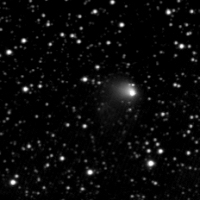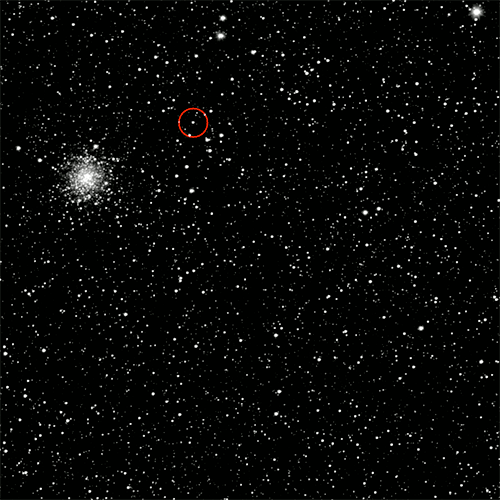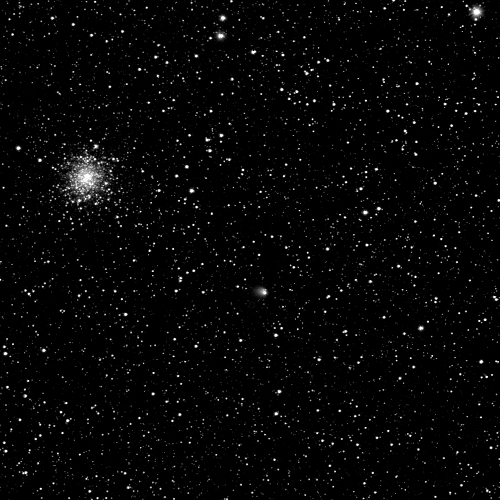Rosetta's target comet is becoming active
15 May 2014
The target of ESA's Rosetta mission has started to reveal its true personality as a comet, its dusty veil clearly developing over the last six weeks.The sequence of images presented here of comet 67P/Churyumov–Gerasimenko were taken between 27 March and 4 May, as the gap between craft and comet closed from around 5 million km to 2 million km.
By the end of the sequence, the comet's dusty veil – the 'coma' – extends some 1300 km into space. By comparison, the nucleus is roughly only 4 km across, and cannot yet be resolved.
The coma has developed as a result of the comet moving progressively closer to the Sun along its 6.5 year orbit. Even though it is still more than 600 million km from the Sun – more than four times the distance between Earth and Sun – its surface has already started to warm, causing its surface ices to sublimate and gas to escape from its rock–ice nucleus.
As the gas escapes, it also carries a cloud of of tiny dust particles out into space, which slowly expands to create the coma.
As the comet continues to move closer to the Sun, the warming continues and activity rises, and pressure from the solar wind will eventually cause some of the material to stream out into a long tail.
Rosetta and the comet will be closest to the Sun in August 2015, between the orbits of Earth and Mars.
The onset of activity now offers scientists the opportunity to study dust production and structures within the coma before getting much closer.
"It's beginning to look like a real comet," says Holger Sierks, principal investigator for OSIRIS, the Optical, Spectroscopic and Infrared Remote Imaging System, at the Max Planck Instute for Solar System Research, Germany. "It's hard to believe that only a few months from now, Rosetta will be deep inside this cloud of dust and en route to the origin of the comet's activity."
In addition, tracking the periodic changes in brightness reveals the nucleus is rotating every 12.4 hours –about 20 minutes shorter than previously thought.
 |
| Close-up of comet 67P/C-G on 30 April 2014. Credit: ESA/Rosetta/MPS for OSIRIS Team MPS/ UPD / LAM/ IAA/ SSO/ INTA/ UPM/ DASP/ IDA |
"These early observations are helping us to develop models of the comet that will be essential to help us navigate around it once we get closer," says Sylvain Lodiot, ESA Rosetta spacecraft operations manager.
OSIRIS and the spacecraft's dedicated navigation cameras have been regularly acquiring images to help determine Rosetta's exact trajectory relative to the comet. Using this information, the spacecraft has already started a series of manoeuvres that will slowly bring it in line with the comet before making its rendezvous in the first week of August.
Detailed scientific observations will then help to find the best location on the comet for the Philae lander's descent to the surface in November.
The images shown here were taken during a six-week period that saw the orbiter's 11 science experiments and the lander and its 10 instruments switched back on and checked out after more than 2.5 years of hibernation.
Earlier this week, a formal review brought these commissioning activities to a close, giving the official 'go' for routine science operations.
"We have a challenging three months ahead of us as we navigate closer to the comet, but after a 10-year journey it's great to be able to say that our spacecraft is ready to conduct unique science at comet 67P/C-G," says Fred Jansen, ESA's Rosetta mission manager.
More about Rosetta
Rosetta is an ESA mission with contributions from its member states and NASA. Rosetta's Philae lander is provided by a consortium led by DLR, MPS, CNES and ASI. Rosetta will be the first mission in history to rendezvous with a comet, escort it as it orbits the Sun, and deploy a lander.
Comets are time capsules containing primitive material left over from the epoch when the Sun and its planets formed. By studying the gas, dust and structure of the nucleus and organic materials associated with the comet, via both remote and in-situ observations, the Rosetta mission should become the key to unlocking the history and evolution of our Solar System, as well as answering questions regarding the origin of Earth's water and perhaps even life.
More about OSIRIS
The scientific imaging system was built by a consortium led by the Max Planck Institute for Solar System Research (Germany) in collaboration with CISAS, University of Padova (Italy), the Laboratoire d’Astrophysique de Marseille (France), the Instituto de Astrofísica de Andalucía, CSIC (Spain), ESA’s Scientific Support Office, the Instituto Nacional de Técnica Aeroespacial (Spain), the Universidad Politécnica de Madrid (Spain), the Department of Physics and Astronomy of Uppsala University (Sweden), and the Institute of Computer and Network Engineering of the TU Braunschweig (Germany). OSIRIS was financially supported by the national funding agencies of Germany (DLR), France (CNES), Italy (ASI), Spain (MEC) and Sweden (SNSB), and the ESA Technical Directorate.
For more information, please contact:
Markus Bauer
ESA Science and Robotic Exploration Communication Officer
Phone: +31 71 565 6799
Mobile Phone: +31 61 594 3 954
Email: markus.bauer![]() esa.int
esa.int
Fred Jansen
ESA Rosetta mission manager
Email: fred.jansen![]() esa.int
esa.int
Matt Taylor
ESA Rosetta project scientist
Email: matthew.taylor![]() esa.int
esa.int
Sylvain Lodiot
ESA Rosetta spacecraft operations manager
Email: sylvain.lodiot![]() esa.int
esa.int
Holger Sierks
OSIRIS Principal Investigator
Max Planck Institute for Solar System Research
Phone: +49 551 384 979 - 242
Email: Sierks![]() mps.mpg.de
mps.mpg.de






